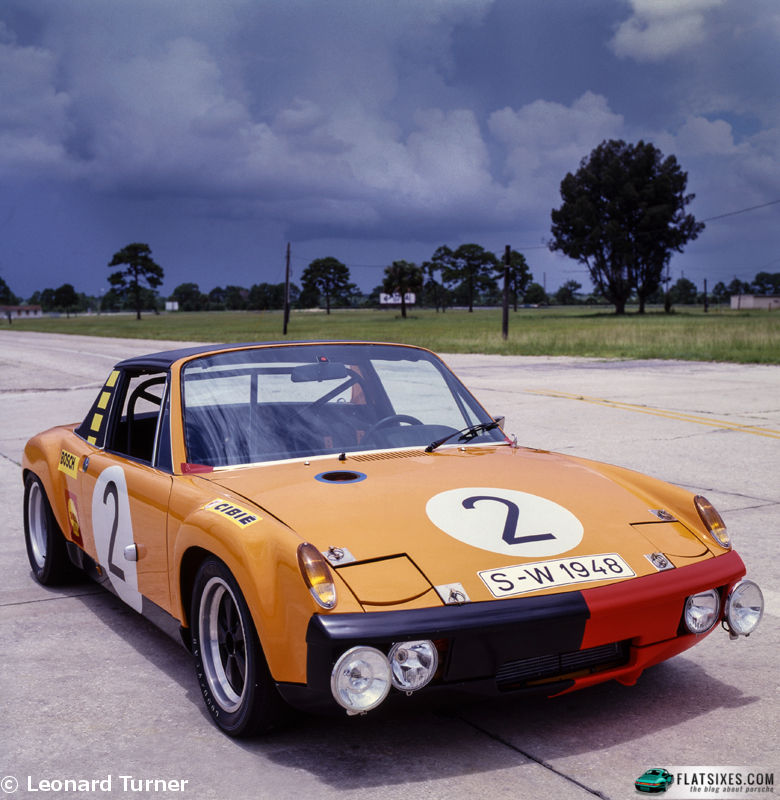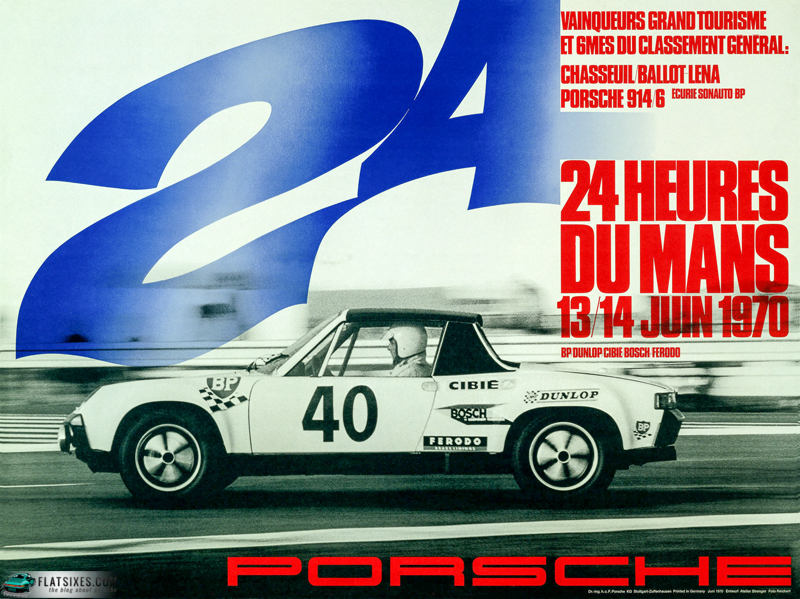The idea was exquisitely simple. In the late 1960s, as Volkswagen sought to add a small sports car and the panache that would come with it to their product line, Porsche was looking for an entry level car within reach of enthusiasts not yet able to afford a 911. The solution worked out by Ferry Porsche and VW’s Heinz Nordhoff appeared to meet both goals. Porsche would design and develop a new mid-engined sports car for VW to be built in the Karmann facility in Osnabrück with power coming from a Volkswagen Type 411 engine. The platform would be designed to accommodate a six-cylinder Porsche engine as well; Porsche would have access to the body shells from Karmann, fit them with six-cylinder 911 power and sell them as Porsches.

Running in Group 4 trim at the 1970 Marathon de la Route, 914/6 GT #2 finished third behind its two sister cars running in Group 6. The three 914/6 GTs scored a hat trick for Porsche in an event that saw only 23 of 64 starters make it to the finish.
Supervising the project was Ferdinand Piëch, nephew of Ferry Porsche then in charge of research and development and the driving force behind the company’s rapid succession of iconic racing cars culminating in the mighty 917. Leading the development was Helmuth Bott, a brilliant engineer who would eventually rise to become R&D chief himself. Thus the four-cylinder 914 was born, along with its upscale brother, the 914/6. Both would be marketed as VW-Porsches everywhere in the world except North America where they were branded as Porsches.
It was a marketing decision that confounded potential buyers and nearly obscured the abundant virtues of the new car. Early reaction from Porsche fans was negative. The styling was widely perceived as bland. Furthermore, how could the four-cylinder car be considered a genuine Porsche, built not in Zuffenhausen but in Osnabrück, with an engine constructed by VW? Defenders pointed out that the much revered 1950 Porsche 356 was not so different—built in Gmünd, Austria, and powered by a hot-rodded VW engine. Unlike the 356, the 914 was designed by Porsche from a clean sheet of paper, but faced an uphill battle toward acceptance.

Porsche’s mid-engine roadster made history at Le Mans in 1970 with an astonishing performance. The lone 914/6 GT came home sixth overall, ahead of all other GT cars and classes.
Still, among its merits the 914 boasted torsional stiffness equal to the 911 coupe and higher than that of the Targa. It was the first mid-engine Porsche production car and the first with coil spring rear suspension. Bott readily revealed that the 914/6 had a six to eight percent advantage in cornering power over a comparable 911. The low center of gravity and low polar moment of inertia gave both versions of the 914 an agility that appealed to the serious enthusiast.
But the 914/6 had an additional problem beyond the marketing that linked it strongly to VW everywhere but in America. The death of Heinz Nordhoff in the spring of 1968 had a calamitous effect on the future of Porsche’s entry level car since the actual contract with Volkswagen failed to specify that Porsche could make the 914/6. It had been an informal agreement between Nordhoff and Ferry Porsche and when Kurt Lotz took over at VW, there was limited enthusiasm for the 914 project and no commitment to facilitating the 914/6.
In the end, Porsche would have to pay Karmann more for the bodies for the 914/6 than it was paying the Osnabrück firm for the 911 bodies they were also producing. As the cost of building the 914/6 edged ever closer to that of the 911, Porsche’s intent to offer it at a significantly lower price grew to be an increasingly marginal effort.
Success Follows Difficult Beginning
In spite of its difficult birth, ambiguous marketing, and questionable profitability, the 914, in both four and six cylinder form, became the most popular Porsche sold in the first half of the 1970s. In all more than 118,000 reached eager buyers, 70 percent of those in North America, where Porsche’s first production- based mid-engine roadsters today enjoy the place of honor they were initially denied. The key to that acceptance was a rapid proliferation of competition models that demonstrated the 914’s Porsche DNA on the great tracks of the world, including Le Mans and the Nürburgring.
But first Porsche engineers needed to find out how much power the 914 chassis could actually take. To that end, in September 1969, even as the 914 was making its public debut at the Frankfurt Show, Ferry Porsche received an unusual 60th birthday present. In the courtyard of the family farm at Zell am See, Austria, stood a silver 914, fully licensed for the street and powered by a slightly detuned version of the potent 908 race engine. With milder cam timing, Weber twin-throated carburetors instead of Bosch fuel injection, and a street exhaust system, the engine’s output was still a vigorous 260 bhp at 7700 rpm.
